Previous Prize Winners
2022/2023
The Innovation Award on Synchrotron Radiation 2022/23 was given to Prof. Dr. Florian Grüner from CFEL, DESY and the University of Hamburg. He received the prize for his achievements in the further development of in-situ and in-vivo tracking using X-ray fluorescence imaging (XFI). This pioneering work paves the way for the precise tracking of immune cells, biomolecules such as active substances, but also antibodies and drug carriers in order to measure their distribution in living organisms in real time. Dr. Arik Willner, Director of Technology at DESY, gave the laudatory speech at the award ceremony on 22 June 2023 in Berlin-Adlershof.
2021
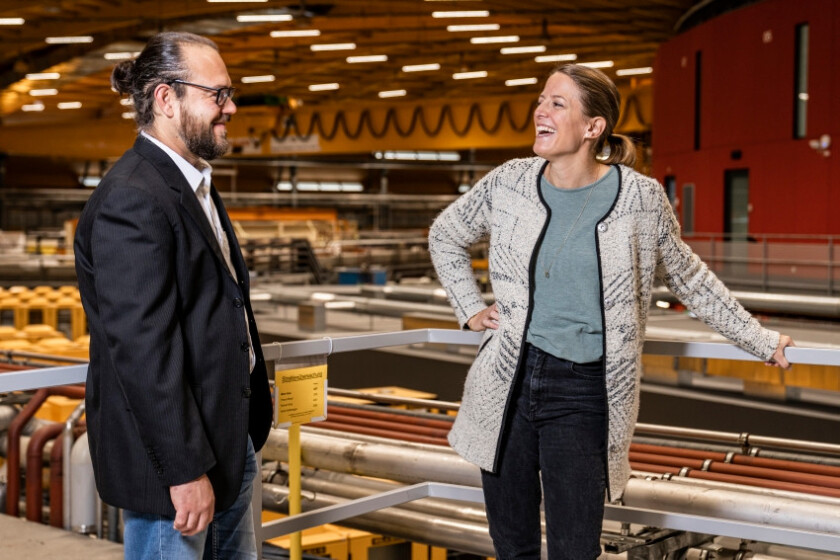
The prize for innovation in synchrotron research went to Professor Marianne Liebi and Dr Manuel Guizar-Sicairos, both from the Paul Scherrer Institute (PSI), Switzerland. © PSI
The Innovation Award on Synchrotron Radiation 2021 went to Professor Marianne Liebi and Dr Manuel Guizar-Sicairos, both from the Paul Scherrer Institute (PSI), Switzerland. They developed and implemented a method to obtain information about textures in materials on the nanoscale from small angle scattering data using mathematical methods (Small Angle Scattering Tensor Tomography). The expert jury emphasised that this method is now used at many synchrotron sources and has opened the door to fascinating studies of hierarchical structures in life and materials science. The laudation was given by Professor Gabriel Aeppli, Head of the Photon Science Division at PSI. The Innovation Award on Synchrotron Radiation is endowed with 3000 € and is sponsored by SPECS GmbH and BESTEC GmbH.
2020

The prize for innovation in synchrotron research went to Guiseppe Sansone, Luca Giannessi, Carlo Callegari and Kevin Prince. © Screenshot Digital User Meeting
The Innovation Award Synchrotron Radiation 2020 went to Prof. Dr. Guiseppe Sansone (University of Freiburg), Dr. Luca Giannessi (Istituto Nazionale di Fisica Nucleare, Frascati, Italy), Dr. Carlo Callegari and Prof. Dr. Kevin Prince (Elettra, Trieste, Italy) for their achievements in the development and application of innovative investigation methods exploiting the radiation emitted by seeded free electron lasers at the FERMI free electron laser at Elettra in Trieste. The prize committee acknowledged "this development is of utmost importance for the future" and "concerns ground-braking experiments even on the attosecond scale". The Innovation Award Synchrotron Radiation is endowed with 3000 Euros and is sponsored by SPECS GmbH and BESTEC GmbH.
2019

The 2019 Innovation Award on Synchrotron Radiation went to PSI researchers Dr. Aldo Mozzanica (2nd from left), Dr. Bernd Schmitt (3rd from left) and Prof. Dr. Heinz Graafsma (4th from left, DESY). It was presented by Prof. Dr. Mathias Richter (5th from left) from the Association of Friends of Helmholtz-Zentrum Berlin. The laudation was held by Prof. Dr. Edgar Weckert, DESY (1st from left) © M. Setzpfand/HZB
On December 5, 2019, during the 11th HZB User Meeting, the Association of Friends of Helmholtz-Zentrum Berlin awarded the Innovation Award on Synchrotron Radiation 2019 to Prof. Dr. Heinz Graafsma, DESY Hamburg, as well as to Dr. Aldo Mozzanica and Dr. Bernd Schmitt, both from the Paul Scherrer Institute (PSI) in Switzerland, for their groundbreaking research and technology development that led to the Adaptive Gain Integrated Pixel Detector (AGIPD) for free-electron laser applications. The laudation was held by Prof. Dr. Edgar Weckert from DESY.
2018
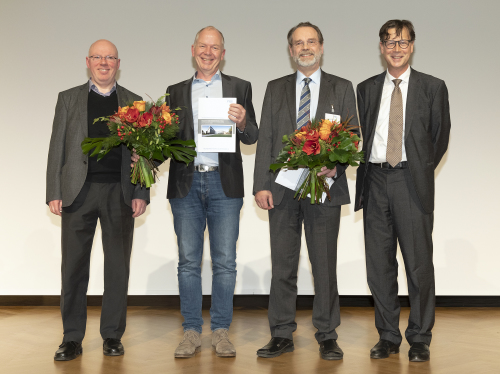
Laudator Prof. Gerd Schneider, award winners Dr. Christian David and Prof. Alexei Erko and Prof. Mathias Richter, Friends of HZB, (From left to right). Copyright: M. Setzpfandt/HZB
The Innovation Award on Synchrotron Radiation 2018 went to Dr. Christian David, also from the Paul Scherrer Institute, and to Prof. Alexei Erko, who recently moved from the HZB to the Institute for Applied Photonics (IAP) in Berlin-Adlershof. The two physicists were honored for their innovative contributions to the application of diffractive X-ray optics, which enable complex X-ray experiments with high resolution. The laudation was held by Prof. Gerd Schneider from the HZB. This time it was not the "ring makers" who were honoured for developing the accelerators, but those who had cut the "diamonds for the ring", Schneider explained pictorially. The Synchrotron Radiation Innovation Award is sponsored by SPECS GmbH and BESTEC GmbH.
2017
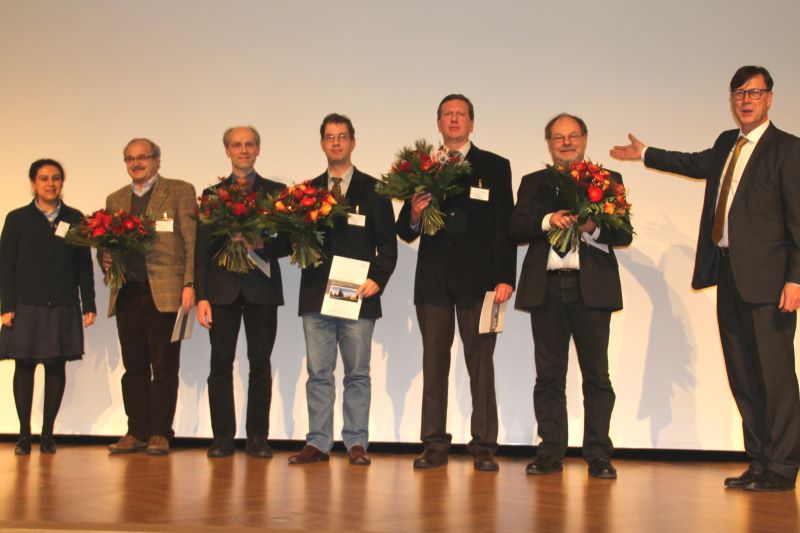
Dr. Atoosa Meseck (Helmholtz-Zentrum Berlin) for the laudation and the awardees from DESY in Hamburg Dr. Mikhail Yurkov, Dr. Markus Tischer, Dr. Bart Faatz, Dr. Evgeny Schneidmiller, and Dr. Siegfried Schreiber together with Prof. Dr. Mathias Richter from the Society of Friends of Helmholtz-Zentrum Berlin (from the left to the right) during the award ceremony on December 14, 2017 in Berlin-Adlershof. Credit: HZB
The Association of Friends of Helmholtz-Zentrum Berlin awarded during the 9th Joint BER II and BESSY II User Meeting on December 14, 2017 the 17th Innovation Award on Synchrotron Radiation which is sponsored by the firms SPECS GmbH and BESTEC GmbH. A team from DESY in Hamburg was bestowed: Dr. Bart Faatz, Dr. Evgeny Schneidmiller, Dr. Siegfried Schreiber, Dr. Markus Tischer and Dr. Mikhail Yurkov for their pioneering work on „Innovative applications of gap-tunable undulators with integrated phase shifters in SASE x-ray FELs“.
2016
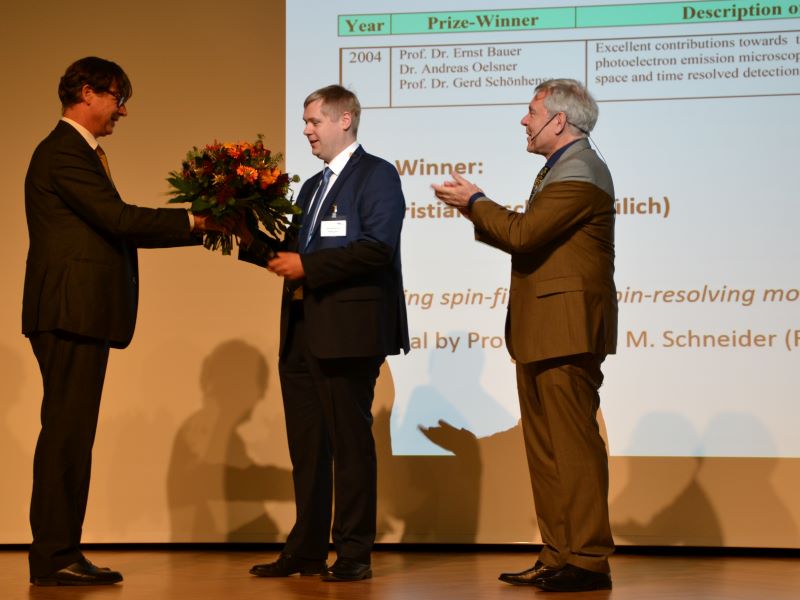
Dr. Christian Tusche together with Prof. Mathias Richter from the Freundeskreis (left) and Prof. Gerd Schönhense from the Johannes Gutenberg-Universität Mainz (right) who delivered the encomium during conferral of the Innovation Prize in Berlin/Adlershof December 8th, 2016 (photo: HZB).
The 2016 Innovation Award on Synchrotron Radiation was bestowed to Dr. Christian Tusche from Forschungszentrum Jülich. The efficiency of spin-resolved electron spectroscopy can be increased by up to four orders of magnitude as a result of his pioneering paper “Imaging Spin-Filters for Spin-Resolving Momentum Microscopy” that substantially resulted from work done at the Max Planck Institute of Microstructure Physics, Halle/Saale, and BESSY II.
The Innovation Prize for Synchrotron Radiation is sponsored by the firms SPECS GmbH and BESTEC GmbH. The encomium at the awards ceremony December 8th, 2016 was delivered by Prof. Gerd Schönhense from the Johannes Gutenberg University Mainz, who had received the Innovation Prize for Synchrotron Radiation as a result of work on a related subject in 2004.
2015
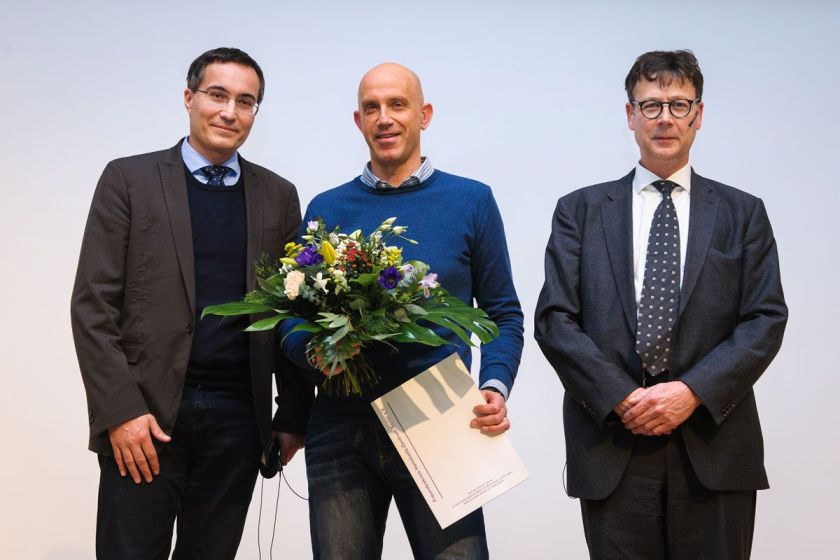
Dr. Claudio Masciovecchio together with Prof. Mathias Richter from the Society of Friends of Helmholtz-Zentrum Berlin (right) and Prof. Alexander Föhlisch from the Helmholtz-Zentrum Berlin (left) who gave the laudation during the ceremony for the Innovation Award on December 10, 2015 in Berlin-Adlershof. Photo: Phil Dera/HZB
The 2015 Innovation Award on Synchrotron Radiation has been given to Dr. Claudio Masciovecchio from the Elettra-Sincrotrone in Trieste. His work on "First transient grating experiment in the soft X-ray range at the FERMI free-electron laser by exploitation of the coherent and multi-wave nature of the four-wave mixing process" has impressively demonstrated the prospects of the worldwide first seeded free electron laser for soft X-rays FERMI. The Innovation Award on Synchrotron Radiation is sponsored by SPECS GmbH and BESTEC GmbH. The laudatory speech during the awards ceremony was delivered by Prof. Alexander Föhlisch from the Helmholtz-Zentrum Berlin.
2014
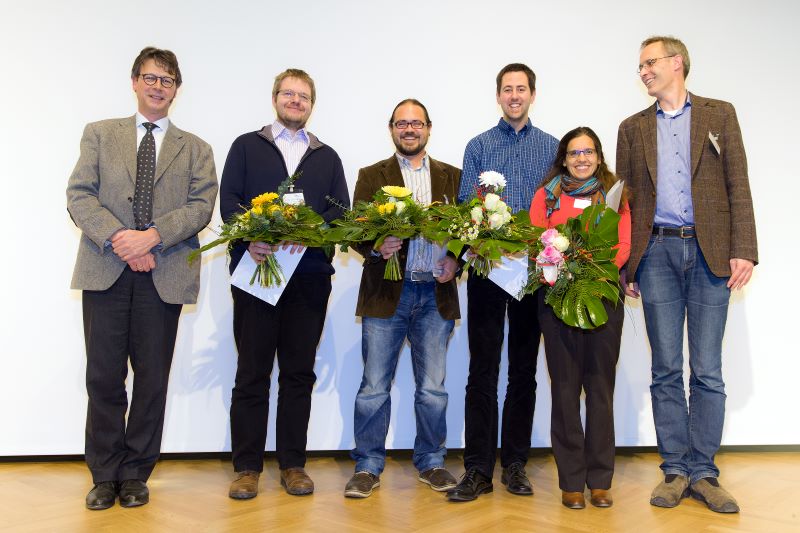
The awardees of the 2014 Innovation Award on Synchrotron Radiation: Dr. Jörg Raabe, PhD Manuel Guizar-Sicairos, Dr. Mirko Holler and PhD Ana Diaz (in the middle from the left to the right) of the OMNY team from PSI at the Swiss Light Source, together with Prof. Mathias Richter from the Society of Friends of Helmholtz-Zentrum Berlin (left) and Prof. Stefan Eisebitt from the Technische Universität Berlin (right) who gave the laudation during the award ceremony on December 4, 2014 in Berlin-Adlershof.
The 2014 Innovation Award on Synchrotron Radiation has been given to Dr. Mirko Holler, PhD Ana Diaz, PhD Manuel Guizar-Sicairos, and Dr. Jörg Raabe of the OMNY team from PSI at the Swiss Light Source. They set new standards for high-resolution 3D X-ray microscopy with their work on methodological development of what is known as ptychography in the area of coherent diffraction imaging. The Innovation Award on Synchrotron Radiation is sponsored by SPECS GmbH and BESTEC GmbH. The laudatory speech during the awards ceremony was delivered by Prof. Stefan Eisebitt from the Technische Universität Berlin.
2013
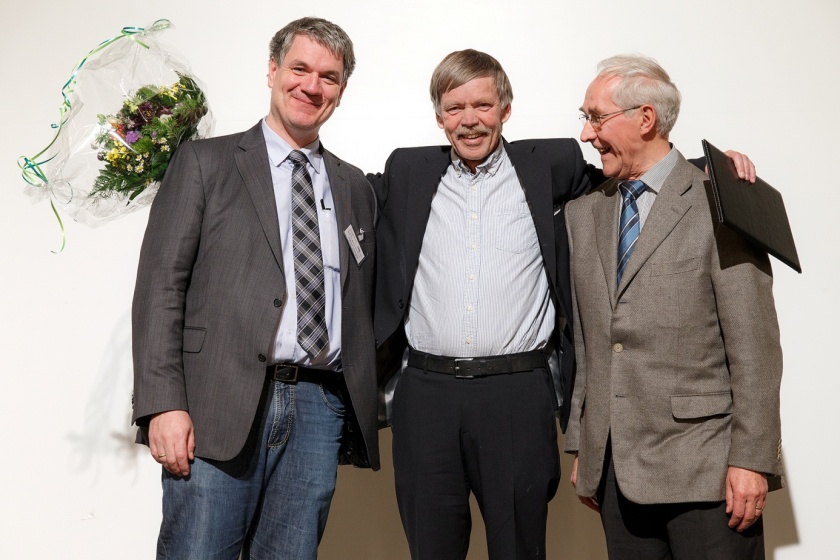
The awardee of the 'Innovation Award on Synchrotron Radiation 2013' Prof. Mikael Eriksson (middle), together with Prof. Wolfgang Gudat from the Society of Friends of Helmholtz-Zentrum Berlin (right) and Prof. Andreas Jankowiak (left) who gave the laudation during the award ceremony on December 5, 2013 in Berlin-Adlershof. Picture: HZB / M. Setzpfand.
The 2013 Innovation-Award on Synchrotron Radiation granted by the Society of Friends of Helmholtz-Zentrum Berlin (HZB) and sponsored by SPECS GmbH and BESTEC GmbH in Berlin, has been bestowed upon Prof. Mikael Eriksson, Machine Director at the MAX IV laboratory in Lund (Sweden) for his outstanding contributions on ‘Realizing the concept and developing the technology of the multi-bend achromat storage ring towards diffraction limited synchrotron light source’. The proof-of-principle of this future technology with high impact on the next generation of storage ring based light sources has already been demonstrated at the former and current MaxLab accelerators. It will now being realized at the MAX IV facility and has already strongly influenced the upgrade programs at APS, SIRIUS, ESRF, and Spring-8.
2012
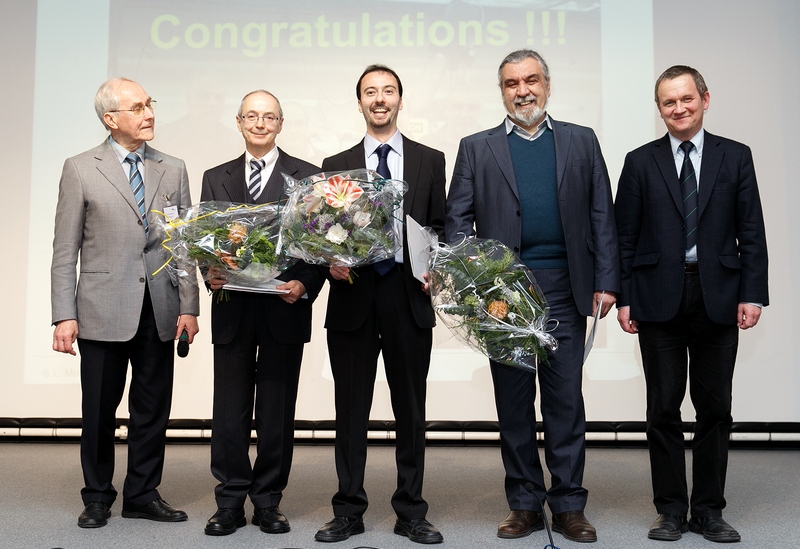
The awardees of the 'Innovation Award on Synchrotron Radiation 2012' Evgeny Saldin (2nd from left), Gianluca Geloni (3rd from left), and Vitali Kocharyan (4th from left), with Wolfgang Gudat from the Society of Friends of Helmholtz-Zentrum Berlin (left) and Serguei Molodtsov (right, Scientific Director XFEL) who gave the laudation during the award ceremony on December 13, 2012 in Berlin-Adlershof.
The 2012 Innovation-Award on Synchrotron Radiation granted by the Society of Friends of Helmholtz-Zentrum Berlin (HZB) and sponsored by SPECS GmbH and BESTEC GmbH in Berlin, has been bestowed upon Gianluca Geloni (European XFEL, Hamburg), Vitali Kocharyan (DESY, Hamburg), Evgeny Saldin (DESY, Hamburg), and Paul Emma (Lawrence Berkeley National Laboratory) for their outstanding contributions on the ‘Development of hard X-ray self-seeding with wake monochromators – a novel approach for dramatic improvement of free electron X-ray lasers’. Their idea of X-ray self-seeding was theoretically developed at XFEL and DESY in Hamburg and for the first time experimentally confirmed at the LCLS facility in Stanford.

